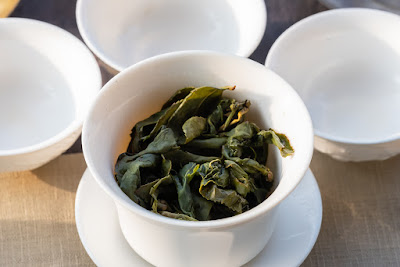 |
| New plantation of Qingxin Oolong where the selected tea comes from |
Compare the next picture with the first and you'll see how quickly the weather can change between noon and afternoon:
Luckily, the sun comes back half an hour later and let me prepare this outdoor Chaxi in the midst of ChangShuHu's tea plantations.
This is my front view from this spot:
And this is when I sit down:
Naturally, I choose to chose winter Alishan Qingxin Oolong I have selected. It was harvested by hand on October 20th, 2019 in ChangShuHu in a new plantation (see the second picture of this article).
The leaves have a light color, because the way this plantation is oriented means it doesn't get much sunshine (the photo shows that half of the trees are in the shade at noon already). White buds are visible on some of the dry rolled leaves: this is a characteristic that only winter high mountain Oolong has.
The dry scent is lightly fruity and completely fresh, of course!
A warm sunset shines on the Chaxi and emphasizes the sweetness of the brew. My aim of brewing this fresh tea here is to see if it really conveys the terroir, the surrounding smells and flavors. And it does perfectly! It's difficult to imagine a more harmonious feeling!
Brewing at an elevation of 1300 meters means the water boils already at 95.7 degrees Celcius. And since it's quite cool outdoors in the late afternoon, one has to be very careful brewing rolled Oolong. If the gaiwan isn't properly preheated, the leaves won't open well and release their flavors. Then you don't know how good your tea is! As you can see, I avoided this problem and got my leaves to open beautifully and fill the gaiwan evenly:
The leaves are quite typical for high mountain Oolong: 3 big leaves, a small leaf and a bud. They are quite thick, because they come from young tree bushes. This probably explains the long, complex and sweet aftertaste.
The feeling couldn't be better!
The brew has a good clarity and the open leaves are so tender that it seems they have just been picked from the plantation!
Winter high mountain Oolong has a sweetness that fits nicely with the cooler and drier weather of November/December. This winter 2019 Alishan is my new flagship, since the spring version sold out faster than expected, 2 weeks ago!




















No comments:
Post a Comment